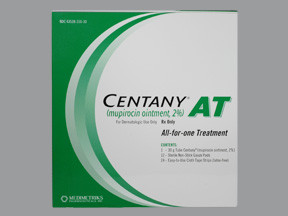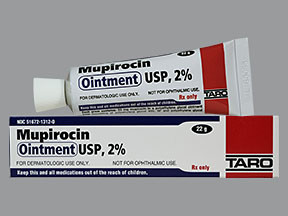MUPIROCIN OINTMENT - TOPICAL
PHONETIC PRONUNCIATION: (mue-PIR-oh-sin)
COMMON BRAND NAME(S): Bactroban
GENERIC NAME(S): mupirocin
Uses
USES: Mupirocin is used to treat certain skin infections (such as impetigo). It is an antibiotic. It works by stopping the growth of certain bacteria.
How to use MUPIROCIN OINTMENT - TOPICAL
HOW TO USE: Read the Patient Information Leaflet if available from your pharmacist before you start using mupirocin and each time you get a refill. If you have any questions, ask your doctor or pharmacist. Use this medication only on the skin. Clean and dry the affected area first. Then apply a small amount of ointment to the area as directed by your doctor, usually 3 times a day. You may cover the treated area with a bandage. Use this medication regularly to get the most benefit from it. Continue to use it for the full time prescribed, even if symptoms disappear after a few days. Stopping the medication too early may result in a return of the infection. Avoid using this medication around your eyes, nose, mouth, or on large areas of damaged or broken skin unless otherwise directed by your doctor. If you accidentally get it in your eyes, nose, or mouth, rinse well with plenty of water. Tell your doctor if your condition does not get better in 3 to 5 days.
Side Effects
Precautions
Interactions
Overdose
Images
Reviews
Faq for MUPIROCIN OINTMENT - TOPICAL
Mupirocin ointment is used topically to treat bacterial skin infections, such as impetigo, folliculitis, and infected eczema.
Mupirocin ointment works by stopping the growth of bacteria. It inhibits bacterial protein synthesis, thereby preventing the bacteria from multiplying and causing infection.
Clean and dry the affected area before applying a thin layer of the ointment. Gently massage it into the skin. Wash your hands before and after use.
No, Mupirocin ointment is specifically indicated for bacterial infections and does not have any effect on fungal infections.
Yes, Mupirocin ointment can be used on open wounds but avoid using it on deep, puncture wounds or animal bites. It is usually recommended to consult a healthcare professional for proper wound care.
Follow the instructions provided by your healthcare professional. Usually, Mupirocin ointment is applied two to three times a day for up to 10 days. Do not exceed the recommended duration of use.
Common side effects may include burning, itching, stinging, or pain at the application site. Rarely, allergic reactions or severe skin reactions may occur. Consult your doctor if you experience any unusual or severe side effects.
Generally, it is considered safe to use Mupirocin ointment during pregnancy or breastfeeding. However, always consult your healthcare provider before using any medication during pregnancy or while breastfeeding.
Yes, Mupirocin ointment can be used on children, but it is recommended to use it under medical supervision.
Disclaimer
IMPORTANT: HOW TO USE THIS INFORMATION: This is a summary and does NOT have all possible information about this product. This information does not assure that this product is safe, effective, or appropriate for you. This information is not individual medical advice and does not substitute for the advice of your health care professional. Always ask your health care professional for complete information about this product and your specific health needs.









No Reviews Yet